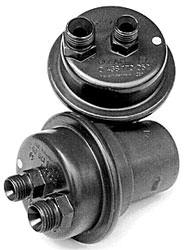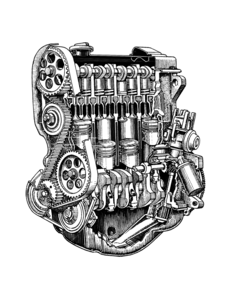TECH TIP: HOT START PROBLEM
Is your accumulator holding the pressure when your car is parked hot?
All Rabbit, Scirocco, Jetta, Dasher, Golf, Quantum and Audi vehicles, from '77 through approximately '88 have CIS fuel injection (continuous injection). One of their classic problems is hot starting. After you turn off the car, the heat from the engine and exhaust pipe soak into the injectors and injection lines and boils the gas into vapor.

Then you have vapor lock. It's kind of backwards vapor lock because vapor lock is usually an air space in the line between the fuel tank and the pump. And the pump can't suck a vacuum, so it spins in the air "vapor" and you sit there and grind and grind and go no place. Bosch installed a number of solutions to this problem, one of which was the fuel pressure accumulator. The fuel pressure accumulator is like an orange juice can with a big spring and rubber diaphragm. When the pump is turned on, this reserve tank of pressurized fuel keeps constant pressure on the fuel at about 50 pounds. And as you remember from your high school physics class that you slept though, a pressurized liquid, be it water/steam or gas/vapor, boils at a much higher temperature if it's pressurized. Therefore, it won't boil in the lines and stays liquid and your pump is able to pump it and pressurize the fuel in your system to allow your injectors to overcome their internal pressure valve in operating. As you know, the CIS injectors have a pressure valve in them which keeps them from leaking and dripping fuel into the cylinder when the engine is off. But this check valve will not open to the pressure of fuel vapor. And therefore, will not open and let the engine start if the fuel has vaporized due to the low pressure caused by the faulty accumulator.
Accumulators fail externally and internally. In all Volkswagen applications the fuel accumulator sits under the rear passenger side seat. In this location it is exposed to salt and external corrosion. Many older cars in the "rust belt" develop leaks due to external rust through of the fuel accumulator. This is usually very easy to spot by the puddle of gas under the car. Check out your rusty accumulator in advance because it's not cool to drive down the street with gas from a pinhole in an accumulator spraying on a nice hot muffler. You don't want to look like one of those fake car crashes in movies where everything burns up.
Defect number two is internal. The internal diaphragm springs a leak and the accumulator gets "water logged" with gas on both sides of the diaphragm and is less effective. This is more common.
When the accumulator is not working, it contributes to the hot start problem. If you have a hot start problem, the very first thing you should probably do is replace the rubber O rings on the injectors, as they only cost about a buck a piece. Bad O rings will cause loss of vacuum, the throttle plate will not lift and it will not start. (Which is a different problem but also a common one.)
Is your accumulator holding the pressure when your car is parked hot?
We purchased a "buyout" of new, late model fuel accumulators that can be used for all Volkswagen applications. They are the latest design and brand new. They are a little smaller than the ones originally used with the early Rabbits and Jettas but they hold slightly higher pressure and work extremely well with a tired system. They are shipped with a rubber sleeve which is only needed on the earlier units to make them fit in the older brackets. Discard this rubber sleeve if it is not needed. If it is needed, just install the new fuel accumulator with the rubber sleeve on it in the old bracket tin the original location using all the original hoses, etc. This will mount up to it exactly. Hope this solves your hot start problem!
WARNING: While our customers have found this information useful, these articles/links are not from technical publications. Information presented here is to give you a general idea of what to do and how to do it. Auto repair, while fun and economical, can be dangerous. There is no way we can warn you of each and every hazard. How can we tell you that when installing a hub cap, don't smoke and have a bucket of gas nearby? If you have no common sense, ignore these articles. Otherwise, read the warnings in the front of the Robert Bentley manual before you proceeded to follow any advice given here.




